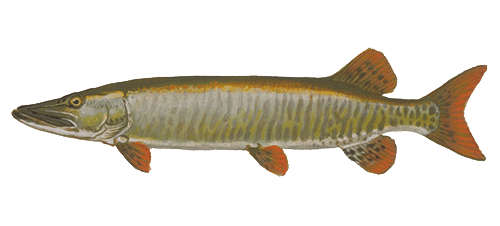
Scientific name:
Esox masquinongy (Esox comes from the old name for pike in Europe and masquinongy comes from the Cree "mashk" meaning deformed and "kinonge" is a pike.
Identification:
Silvery background with dark, variable markings, often as oblique stripes, spots, or blotches, or even with scarcely any markings. Belly white with small spots. Fins green to red-brown with dark blotches. Young (less than 150 ram) with broad scalloped bars of olive green along sides and gold mid-dorsal stripe on back; belly white.
Distribution:
The muskellunge occurs in all three drainage basins in Wisconsin (Lake Michigan, Mississippi River, and Lake Superior) but is most widely distributed in the Chippewa, Flambeau, St. Croix, Black, and Wisconsin rivers of the Mississippi basin. Its presence in central and southern Wisconsin is the result of widespread stocking of fry and fingerlings.
Spawning:
Within the north and south limits of the Wisconsin muskellunge range, spawning occurs from mid-April to mid-May, with the peak occurring early in the season. Optimum spawning temperature is about 55º F, but may range from 49 - 60º F. Eggs are usually deposited indiscriminantly over several hundred yards of shoreline. There is no parental care. Adult spawners return to the same spawning ground in consecutive years.
Angling:
The natural home for the musky is in the northern lakes and rivers. It is a solitary fish and lurks in weed beds or other protective cover. Anglers usually have the best luck fishing during the daytime. Large plugs, spoons, and bucktails are the best artificial baits. A live fish bait 10-12 inches long is also good.